ASUS PQ321Q UltraHD Monitor Review: Living with a 31.5-inch 4K Desktop Display
by Chris Heinonen on July 23, 2013 9:01 AM ESTUniformity is tested by using 25 locations across the screen and measuring the color checker chart at each of them. From there we can pull out contrast, black and white uniformity, and color uniformity. This review is the first to utilize the newest measurement available in CalMAN 5.1.2: dE From Center. Now instead of measuring the dE2000 at every location, we measure it relative to the center measurement.
This gives us a true uniformity measure. I could measure the left side and the right side of the monitor and get a dE2000 of 2.0 for each side. What that doesn’t tell me is that the left side might be red tinted, and the right side blue tinted, while the center might be green tinted. In this case they could all measure the same dE2000, but look totally different. By comparing the measured values to the center, we get an actual measurement of if one area of the screen will look the same as another area. Since we always use the center of the screen as our calibration target, which is why everything is measured relative to that.
Starting out with White Uniformity, we see decent but not amazing results. The panel stays within +/- 10% for the center, but falls down to a 17% variation at the edges. The light fall-off is relatively high, and makes me wonder if the look of the panel, and its thin design, might place a bit of emphasis on style over substance.
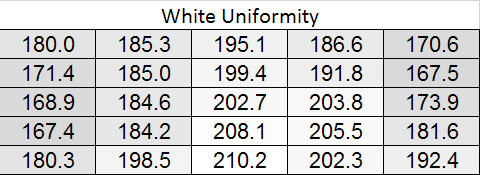

With the black level charts we see similar results. The middle of the panel is +/- 10% again, but the edges fall off to a nearly 20% difference. There is a curious rise in black level in one measure where there was a fall-off in white level, but otherwise the results between the two measurements are similar.
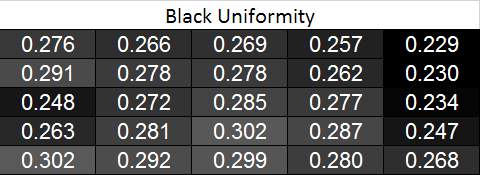
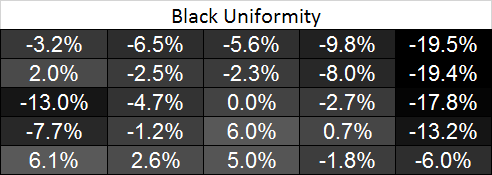
Looking at the resulting contrast, the numbers here are much closer to 100%, which we expect to see. Areas with light fall-off affect the white and black levels almost equally, so the contrast ratios are very similar all across the screen. That gives us a 700:1 expected contrast ratio for the screen as a whole.
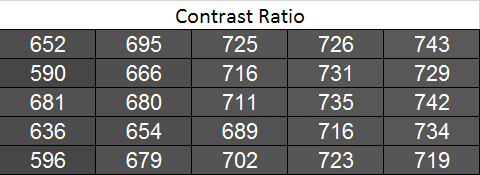
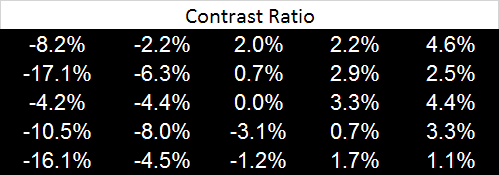
Now we can see the new dE2000 From Center data. The issues here crop up at the outsides of the screen, where we see the backlighting issues earlier. Uneven lighting is the issue most likely to cause color issues on the screen, and that is certainly backed up here. In the center of the screen, you are going to not see a difference in colors when you look directly at the screen. With a light loss of less than 10%, and a color dE2000 of <2 for most of the center screen, everything will look identical. As you get to the extreme edges you will run into more issues. I will need more monitors to be tested with this new method, but I think this is going to wind up as a good result in the end.

Going with an LED lighting system, and not a backlit array one, is always a bit of a concern for me. Overall the PQ321Q does well for uniformity for using one, and it avoids some of the massive issues we have seen with some LED systems before. But we are looking for near-perfection from the ASUS and it can’t quite do that. The center 60% of the screen is excellent overall, and for most people that will mean you may not notice these issues at all, but they are there.










166 Comments
View All Comments
NLPsajeeth - Tuesday, July 23, 2013 - link
Great review.While dual HDMI 4k doesn't work at the moment, NVIDIA are working on hacks to their driver (pcper has a beta copy for testing) so you should see this functionality soon.
If NVIDIA actually supported 2x1 and 2x2 Surround with any monitor, they wouldn't have to resort to such hacks but apparently artificially crippling their Windows driver to preserve Quadro revenue is more important.
Tiled 4K displays are going to be more common with all the delays HDMI 2 is facing. 10-bit color is also going to be standard with all these displays. So I have to wonder how long they can keep crippling their windows driver and how scalable is having EDID whitelist for these types of monitors.
On the plus side, at least the GeForce Linux drivers aren't crippled like this.
Steveymoo - Tuesday, July 23, 2013 - link
Great, finally. I also find it irritating that tech built for disposible, none productive consumers is being given priority for improvements over professional desktop hardware (which would give tangible benefits to people doing actual work.)You mention the new tech uses a more responsive chemical composition, and I can't see a refresh rate in your spec list. Are we likely to ever see these screens run above 60hz? Probably not.
cheinonen - Tuesday, July 23, 2013 - link
Right now I'm not sure that DisplayPort can handle this resolution at refresh rates above 60 Hz. HDMI 2.0 should allow for up to 120 Hz at that resolution, at least if they follow the full Rec. 2020 UHD spec, but that keeps getting delayed.DanNeely - Tuesday, July 23, 2013 - link
Is HDMI2.0 4k@120hz a dual cable solution? I looked at what's written up in Wikipedia and it's listed as maxing out at 4k@60hz; the same limit as DP 1.2.cheinonen - Tuesday, July 23, 2013 - link
HDMI 2.0 isn't final or announced yet. Any specs that are out there for it are rumors right now. The UHD spec, Rec. 2020, calls for up to 120Hz at 8K resolutions. I don't think we'll see that, but I'd think we see 120Hz at 4K because you need at least 96 Hz to support high frame rate 3D, like The Hobbit, if that ever comes to the home.DanNeely - Tuesday, July 23, 2013 - link
4k@120hz would be nice; but even at only 24bit color that's a 24 gigabit datastream. Short of going stealth-dual cable by adding additional data lines I don't think the technology is here to do that at an affordable cost in the near future.madmilk - Tuesday, July 23, 2013 - link
Thunderbolt shows that it is possible to have 40Gbps in a DisplayPort socket. Certainly not cheap though. I don't see the active cables being a necessity though, so long as fiber is not required.sheh - Tuesday, July 23, 2013 - link
Would be nice if it supported 120Hz at least at 1920x1080. It certainly supports the bandwidth already.dishayu - Tuesday, July 23, 2013 - link
I think 31.5 inches is slightly too big and 30Hz WAY too low. Just like Chris says it's hard to go to a lower resolution display. I think, for me it is hard to give up the amazing IPS colors and 120Hz refresh rate. And I don't think there are any 27 inch 4K, 120Hz monitors in the pipeline for the next 5 years. (And we're not even talking affordle yet). Looks like i'm going to be stuck at 27 inch 1440p, 120Hz for some time to come.cheinonen - Tuesday, July 23, 2013 - link
The ASUS runs at 60Hz with either a DisplayPort 1.2 connection using MST (how I tested) or dual HDMI 1.4 outputs, which I don't have on my graphics card and couldn't test.